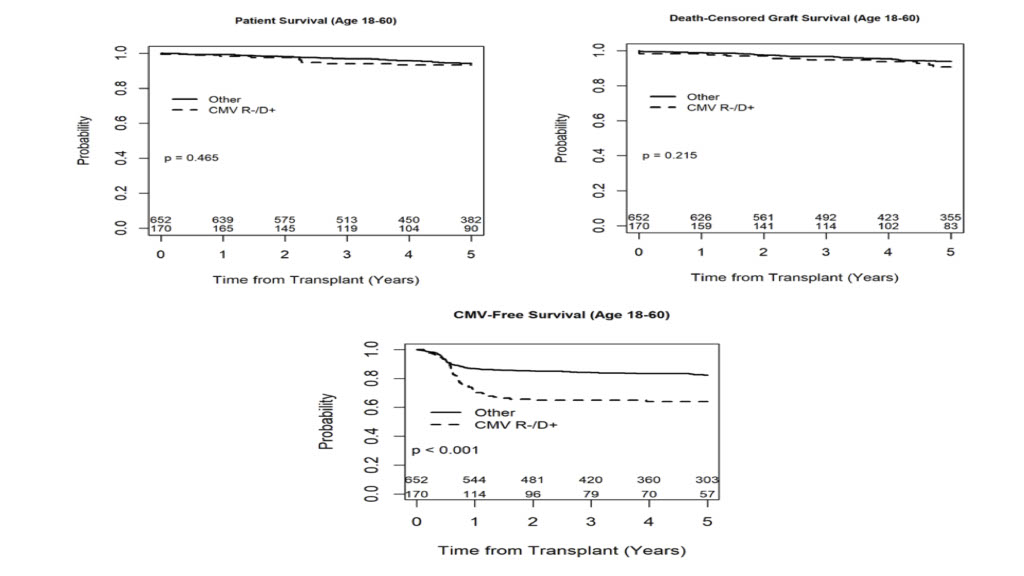Survival Outcomes in Kidney Transplant Recipients Aged 18-60 Years by CMV Discordance Status: A Multivariable Analysis
A. Dinesh1, T. Shaker1, S. Jackson2, S. Riad3, T. L. Pruett1
1Division of Transplantation, Department of Surgery, University of Minnesota, Minneapolis, MN, 2Biostatistics, Analytics Consulting Services- Solid Organ Transplant, M Health Fairview, Minneapolis, MN, 3Department of Medicine, University of Minnesota, Minneapolis, MN
Meeting: 2021 American Transplant Congress
Abstract number: 783
Keywords: Cytomeglovirus, Graft survival, Kidney transplantation, Survival
Topic: Clinical Science » Infectious Disease » Kidney Infectious Non-Polyoma & Non-Viral Hepatitis
Session Information
Session Name: Kidney Infectious Non-Polyoma & Non-Viral Hepatitis
Session Type: Poster Abstract
Session Date & Time: None. Available on demand.
Location: Virtual
*Purpose: Despite advances in CMV therapeutics, CMV infection can pose significant comorbidity after transplantation. We sought to examine the impact of high-risk CMV discordance in our primary kidney transplant recipient population aged 18-60.
*Methods: We retrospectively reviewed all primary kidney transplant recipients aged 18-60 years from 2008-2019. At our institution, we use Thymoglobulin (r-ATG) as induction with early steroid withdrawal followed by CNI plus MMF maintenance, and typically patients receive CMV prophylaxis with Valganciclovir for 90 days for low-risk (CMV IgG R+/D+, R+/D- or R-/D-) and 180 days for high-risk (CMV IgG R-/D+) status. We stratified our study population into clinically high-risk status recipients (CMV IgG R-/D+) (n=170) and low-risk status recipients (CMV IgG R+/D+, R+/D- or R-/D-) (n=652). Kaplan-Meier curves were generated for recipient survival, death-censored graft survival, and CMV-infection-free survival with follow-up censored at 5 years post-transplant. We examined the effect of CMV high-risk status on outcomes of interest in a multivariable Cox proportional hazards model adjusted for age, gender, race, BMI, maintenance immunosuppression, donor type, and donor age. CMV-free survival was not modeled due to severe proportional hazard violations.
*Results: In univariate analysis, no difference was noted in patient survival (log-rank, p=0.465) or death-censored graft survival (log-rank, p=0.215) between low and high-risk groups. However, CMV-free survival was significantly lower in the high-risk group (log-rank, p<0.001). High-risk recipients had a 35% cumulative incidence of CMV infection at two years post-transplant, compared to 15% in the low-risk group. In the multivariable model, CMV status was not a predictor of patient survival (HR=0.71, 95% C.I. (0.26-1.90), p=0.50) or graft survival (HR=1.01, 95% C.I. (0.40-2.57), p=0.98).
*Conclusions: In primary kidney transplant recipients aged 18-60 years, receiving r-ATG induction immunosuppression followed by CNI plus MMF maintenance with early steroid withdrawal, the incidence of post-transplant CMV viremia is significantly higher in high-risk CMV discordant recipients. However, it did not predict the patient or graft survival.
To cite this abstract in AMA style:
Dinesh A, Shaker T, Jackson S, Riad S, Pruett TL. Survival Outcomes in Kidney Transplant Recipients Aged 18-60 Years by CMV Discordance Status: A Multivariable Analysis [abstract]. Am J Transplant. 2021; 21 (suppl 3). https://atcmeetingabstracts.com/abstract/survival-outcomes-in-kidney-transplant-recipients-aged-18-60-years-by-cmv-discordance-status-a-multivariable-analysis/. Accessed December 22, 2025.« Back to 2021 American Transplant Congress

